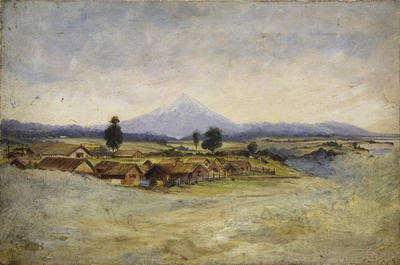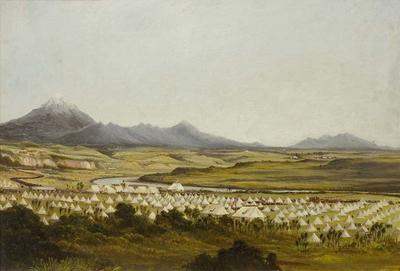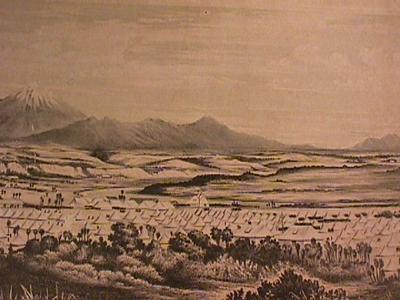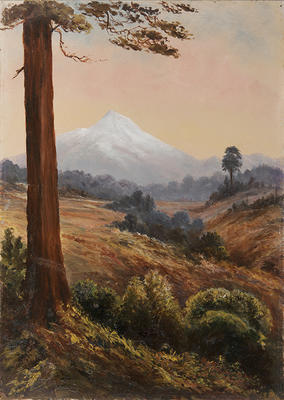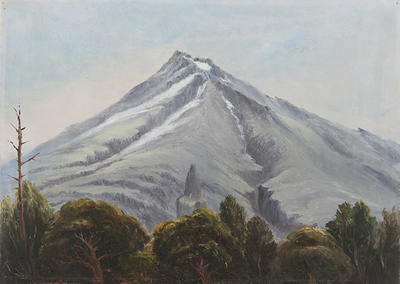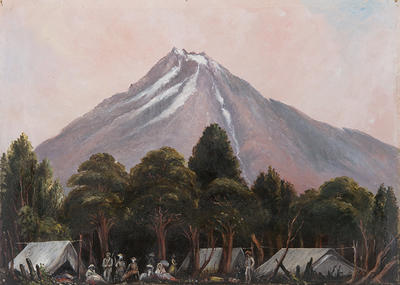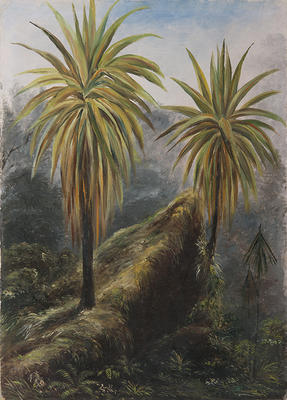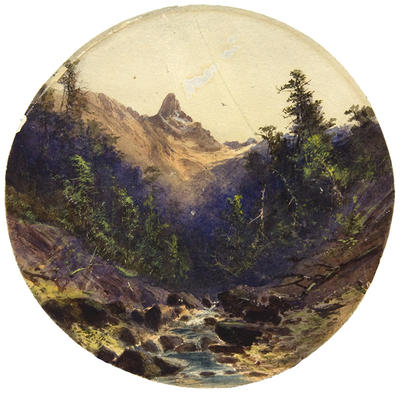Edith Stanway Halcombe
Date of birth / Date established
1844
Date of death / Date closed
1903
Place of birth / Place established
Place of death / Place closed
Person/Corporate type
Individual
Biography
Edith Stanway Swainson was born on 27 April 1844 in the Hutt valley, Wellington, New Zealand, the seventh child of William Swainson, a naturalist and artist, and the second child of Anne Grasby, his second wife. Her childhood was spent in the Hutt valley and on her father's estate in Rangitikei. At an early age members of the family interested in art were given instruction by their father. Edith's earliest known works are pencil sketches copied from her father's drawings in the late 1850s. She became so proficient that it is sometimes difficult to distinguish between the work of the two artists.
She married Arthur William Follett Halcombe at Hutt on 3 December 1863, and settled at Westoe, Rangitikei. By this time she had a working knowledge of contemporary European painting conventions and a keen interest in recording her surroundings. Unlike many other women artists she was able to continue to produce work throughout her life as a settler and mother of eight children. Her surviving works from the 1860s are mainly watercolours and pencil drawings.
By 1874 the Halcombes had moved to Feilding where Arthur was managing the settlement of the Manchester block, a densely forested area between the Rangitikei River and the Ruahine Range. In this environment Edith produced a collection of work recording the dramatic transformation of bush wilderness to pasture and town. Published as two-tone lithographs in The Feilding settlement, Manchester block, Manawatu, New Zealand in 1878, this work illustrated a text by Arthur intended to encourage further immigration. By doing her own etching Edith avoided the distortion often imposed on New Zealand topographical art by European lithographers. Perhaps unintentionally, her illustrations reveal some of the isolation and struggle of settler life.
New Zealand-born and familiar with local conditions, Edith Halcombe had a range of practical skills useful to an immigrant community. In Feilding she nursed the sick and assisted new arrivals with the social and psychological difficulties of an unfamiliar environment. She worked to set up community institutions, in 1876 taking charge of the Sunday school and later helping to establish St John's Anglican Church, where she became organist.
In the early 1870s Edith Halcombe was given a Jersey cow, and in the following years acquired and developed a herd of approximately 20, whose sale in 1879 was an important step in the dissemination of the breed in New Zealand. Confidence in her judgement was high and in 1881 she was commissioned to obtain Jersey breeding stock on a trip to Europe. The two animals she purchased contributed to the bloodlines of Jersey herds throughout the country.
In 1881 Edith Halcombe became a member of the Auckland Society of Arts and exhibited with them until 1884. It seems likely that she lived in Auckland over this time, as she owned property there and produced a number of lithograph views of the city. By 1885 she was living in Lichfield, near Putaruru.
In 1886 they settled on a farm at Urenui near New Plymouth. Edith Halcombe continued as a member of the Auckland Society of Arts, and won several prizes for her oil paintings in Taranaki. Her work in this medium is believed to be among the first executed by a New Zealand-born artist. In 1890 she was a member of a team assisting Sir William Fox, a relative by marriage, in an ascent of Mt Taranaki. He failed in his attempt to prove that a teetotaller of advanced age had the same strength as a man of 45, and the climb is on record as one of the longest. Edith's series of oils depicting various stages of the ascent, including Fox being hauled up by rope, are vivid and lively.
For many years Arthur Halcombe suffered from illness and Edith nursed him until his death in 1900. Her artistic output declined over this period. On 14 June 1903 her body was found washed up on the beach near the mouth of the Waitotara River. A coroner's jury found that she had drowned, but there was 'no evidence to say how the body got into the water.'
(source: http://www.teara.govt.nz/en/biographies/2h3/1)
She married Arthur William Follett Halcombe at Hutt on 3 December 1863, and settled at Westoe, Rangitikei. By this time she had a working knowledge of contemporary European painting conventions and a keen interest in recording her surroundings. Unlike many other women artists she was able to continue to produce work throughout her life as a settler and mother of eight children. Her surviving works from the 1860s are mainly watercolours and pencil drawings.
By 1874 the Halcombes had moved to Feilding where Arthur was managing the settlement of the Manchester block, a densely forested area between the Rangitikei River and the Ruahine Range. In this environment Edith produced a collection of work recording the dramatic transformation of bush wilderness to pasture and town. Published as two-tone lithographs in The Feilding settlement, Manchester block, Manawatu, New Zealand in 1878, this work illustrated a text by Arthur intended to encourage further immigration. By doing her own etching Edith avoided the distortion often imposed on New Zealand topographical art by European lithographers. Perhaps unintentionally, her illustrations reveal some of the isolation and struggle of settler life.
New Zealand-born and familiar with local conditions, Edith Halcombe had a range of practical skills useful to an immigrant community. In Feilding she nursed the sick and assisted new arrivals with the social and psychological difficulties of an unfamiliar environment. She worked to set up community institutions, in 1876 taking charge of the Sunday school and later helping to establish St John's Anglican Church, where she became organist.
In the early 1870s Edith Halcombe was given a Jersey cow, and in the following years acquired and developed a herd of approximately 20, whose sale in 1879 was an important step in the dissemination of the breed in New Zealand. Confidence in her judgement was high and in 1881 she was commissioned to obtain Jersey breeding stock on a trip to Europe. The two animals she purchased contributed to the bloodlines of Jersey herds throughout the country.
In 1881 Edith Halcombe became a member of the Auckland Society of Arts and exhibited with them until 1884. It seems likely that she lived in Auckland over this time, as she owned property there and produced a number of lithograph views of the city. By 1885 she was living in Lichfield, near Putaruru.
In 1886 they settled on a farm at Urenui near New Plymouth. Edith Halcombe continued as a member of the Auckland Society of Arts, and won several prizes for her oil paintings in Taranaki. Her work in this medium is believed to be among the first executed by a New Zealand-born artist. In 1890 she was a member of a team assisting Sir William Fox, a relative by marriage, in an ascent of Mt Taranaki. He failed in his attempt to prove that a teetotaller of advanced age had the same strength as a man of 45, and the climb is on record as one of the longest. Edith's series of oils depicting various stages of the ascent, including Fox being hauled up by rope, are vivid and lively.
For many years Arthur Halcombe suffered from illness and Edith nursed him until his death in 1900. Her artistic output declined over this period. On 14 June 1903 her body was found washed up on the beach near the mouth of the Waitotara River. A coroner's jury found that she had drowned, but there was 'no evidence to say how the body got into the water.'
(source: http://www.teara.govt.nz/en/biographies/2h3/1)

